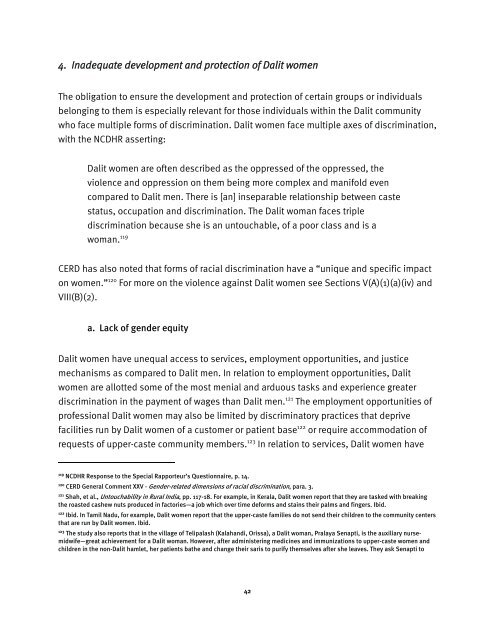Caste Discrimination against India's âUntouchablesâ - Human Rights ...
Caste Discrimination against India's âUntouchablesâ - Human Rights ...
Caste Discrimination against India's âUntouchablesâ - Human Rights ...
You also want an ePaper? Increase the reach of your titles
YUMPU automatically turns print PDFs into web optimized ePapers that Google loves.
4. Inadequate development and protection of Dalit women<br />
The obligation to ensure the development and protection of certain groups or individuals<br />
belonging to them is especially relevant for those individuals within the Dalit community<br />
who face multiple forms of discrimination. Dalit women face multiple axes of discrimination,<br />
with the NCDHR asserting:<br />
Dalit women are often described as the oppressed of the oppressed, the<br />
violence and oppression on them being more complex and manifold even<br />
compared to Dalit men. There is [an] inseparable relationship between caste<br />
status, occupation and discrimination. The Dalit woman faces triple<br />
discrimination because she is an untouchable, of a poor class and is a<br />
woman. 119<br />
CERD has also noted that forms of racial discrimination have a “unique and specific impact<br />
on women.” 120 For more on the violence <strong>against</strong> Dalit women see Sections V(A)(1)(a)(iv) and<br />
VIII(B)(2).<br />
a. Lack of gender equity<br />
Dalit women have unequal access to services, employment opportunities, and justice<br />
mechanisms as compared to Dalit men. In relation to employment opportunities, Dalit<br />
women are allotted some of the most menial and arduous tasks and experience greater<br />
discrimination in the payment of wages than Dalit men. 121 The employment opportunities of<br />
professional Dalit women may also be limited by discriminatory practices that deprive<br />
facilities run by Dalit women of a customer or patient base 122 or require accommodation of<br />
requests of upper-caste community members. 123 In relation to services, Dalit women have<br />
119<br />
NCDHR Response to the Special Rapporteur’s Questionnaire, p. 14.<br />
120<br />
CERD General Comment XXV - Gender-related dimensions of racial discrimination, para. 3.<br />
121<br />
Shah, et al., Untouchability in Rural India, pp. 117-18. For example, in Kerala, Dalit women report that they are tasked with breaking<br />
the roasted cashew nuts produced in factories—a job which over time deforms and stains their palms and fingers. Ibid.<br />
122<br />
Ibid. In Tamil Nadu, for example, Dalit women report that the upper-caste families do not send their children to the community centers<br />
that are run by Dalit women. Ibid.<br />
123<br />
The study also reports that in the village of Telipalash (Kalahandi, Orissa), a Dalit woman, Pralaya Senapti, is the auxiliary nursemidwife—great<br />
achievement for a Dalit woman. However, after administering medicines and immunizations to upper-caste women and<br />
children in the non-Dalit hamlet, her patients bathe and change their saris to purify themselves after she leaves. They ask Senapti to<br />
42

















